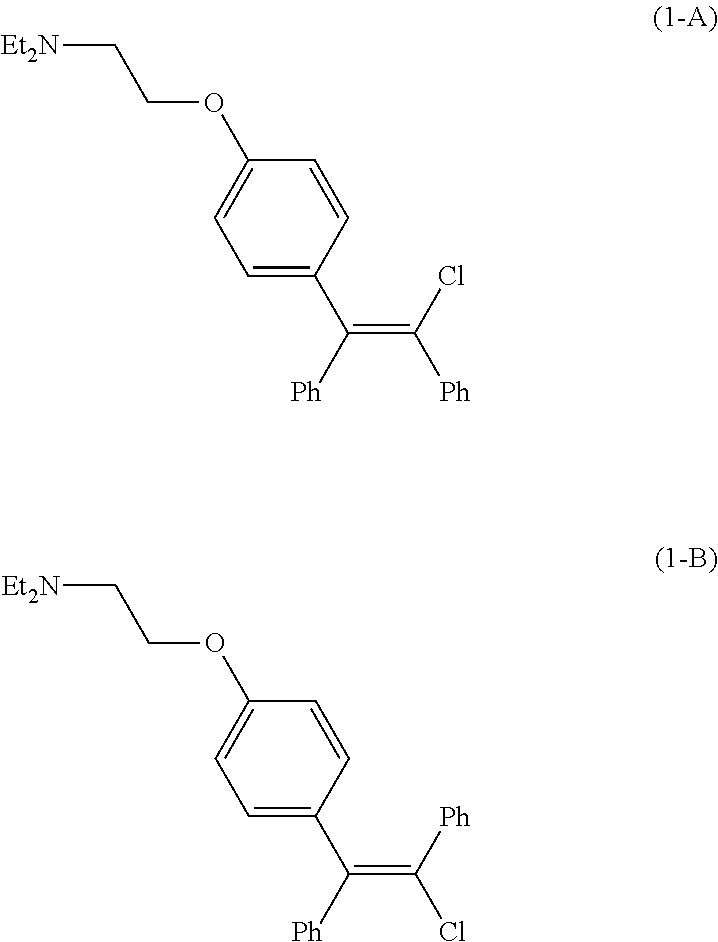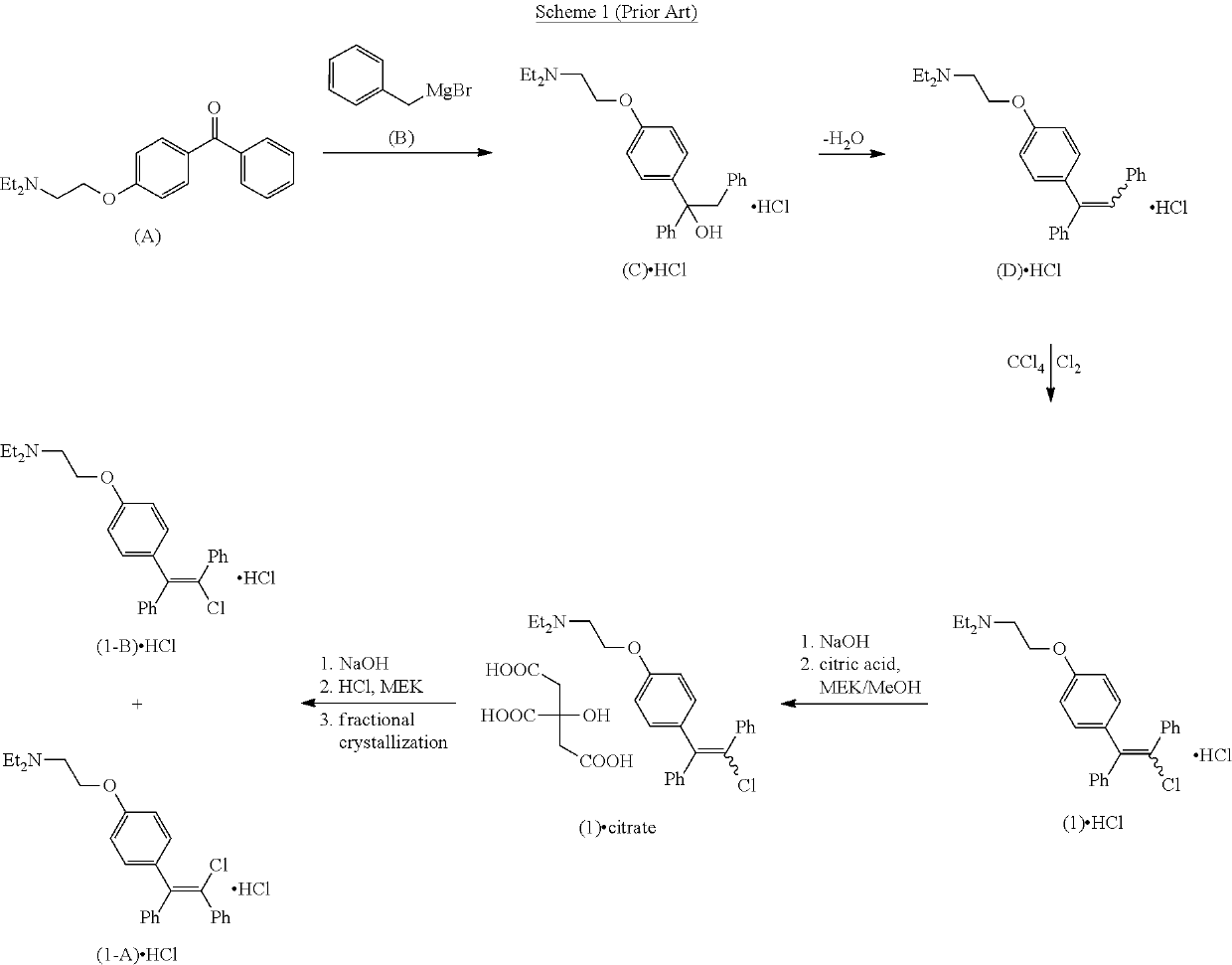Processes for the preparation of zuclomiphene and intermediates thereof
a technology of zuclomiphene and process, applied in the field of process to intermediates, can solve the problems of low overall yield of known methods for the preparation of zuclomiphene, lack of stereo control of methods, etc., and achieve good overall yield and high isomeric purity.
- Summary
- Abstract
- Description
- Claims
- Application Information
AI Technical Summary
Benefits of technology
Problems solved by technology
Method used
Image
Examples
example 1
on of (Z)-4-(2-Chloro-1,2-Diphenylethenyl) Fluorobenzene (Compound of Formula (2-A1))
[0154]
[0155]A mixture of diphenylacetylene (1.00 g, 5.61 mmol) and nickel(II) chloride hexahydrate (0.0029 g, 0.021 mmol, 0.4 mol %) was purged with nitrogen gas three times prior to addition of toluene (15 mL), and a 1 M solution of 4-fluorophenylmagnesium bromide in tetrahydrofuran (6.7 mL, 6.7 mmol). The reaction mixture was then heated to 60° C. and maintained at this temperature until all of the diphenylacetylene was consumed. The reaction mixture was then cooled to room temperature and N-chlorosuccinimide (0.90 g, 6.73 mmol) was charged. Following a period of stirring at room temperature for two hours, the reaction mixture was charged into saturated aqueous ammonium chloride solution and extracted with methyl t-butyl ether. The organic phase was washed with dilute sodium hydroxide, water and brine prior to filtration through anhydrous sodium sulfate and evaporation to dryness in vacuo to affor...
example 1a
n of (Z)-4-(2-chloro-1,2-diphenylethenyl) fluorobenzene (Compound of Formula (2-A1))
[0158]
[0159]Isopropyl magnesium chloride (2.0 M in THF, 98 mL, 196.4 mmol) was added to 1-fluoro-4-iodobenzene (43.60 g, 196.4 mmol) and the mixture was stirred at room temperature for 30 minutes. Toluene (125 mL) was charged to this mixture and the solution was distilled to afford a residue of the Grignard reagent. Diphenyl acetylene (25.00 g, 140.3 mmol) and nickel (II) chloride hexahydrate (0.67 g, 2.81 mmol) was dissolved in toluene (225 mL), purged with nitrogen gas three times and stirred at room temperature. The acetylene solution was charged to the Grignard residue at room temperature followed by a toluene wash (25 mL). The reaction was then heated to 70-75° C. until all the diphenylacetylene was consumed. A flask containing 1,3-dichloro-5,5-dimethyl-2,4-imidazolidinedione (69.09 g, 350.7 mmol) and toluene (125 mL) was heated to 50-55° C. To the flask containing 1,3-dichloro-5,5-dimethyl-2,4-...
example 2
on of (Z)-4-(2-chloro-1,2-diphenylethenyl) methoxybenzene (compound of Formula (2-A3′))
[0161]
[0162]4-Bromoanisole (0.84 mL, 6.73 mmol) was added over one hour to a suspension of magnesium turnings (0.18 g, 7.29 mmol) in tetrahydrofuran (6 mL) to afford a solution of 4-methoxyphenylmagnesium bromide. A dry flask containing a mixture of diphenylacetylene (1.00 g, 5.61 mmol) and nickel(II) chloride hexahydrate (0.0029 g, 0.021 mmol, 0.4 mol %) was purged with nitrogen gas three times prior to addition of toluene (15 mL), and the prepared 4-methoxyphenylmagnesium bromide solution (6.7 mL, 6.7 mmol). The reaction mixture was then heated to 60° C. and maintained at this temperature until all of the diphenylacetylene was consumed. The reaction mixture was then cooled to room temperature and N-chlorosuccinimide (0.90 g, 6.73 mmol) was charged. Following a period of stirring at room temperature for 1.5 hours, the reaction mixture was charged into saturated aqueous ammonium chloride solution ...
PUM
| Property | Measurement | Unit |
|---|---|---|
| Temperature | aaaaa | aaaaa |
| Temperature | aaaaa | aaaaa |
| Fraction | aaaaa | aaaaa |
Abstract
Description
Claims
Application Information
 Login to View More
Login to View More - R&D
- Intellectual Property
- Life Sciences
- Materials
- Tech Scout
- Unparalleled Data Quality
- Higher Quality Content
- 60% Fewer Hallucinations
Browse by: Latest US Patents, China's latest patents, Technical Efficacy Thesaurus, Application Domain, Technology Topic, Popular Technical Reports.
© 2025 PatSnap. All rights reserved.Legal|Privacy policy|Modern Slavery Act Transparency Statement|Sitemap|About US| Contact US: help@patsnap.com



